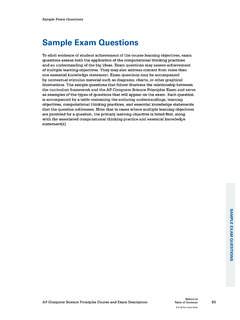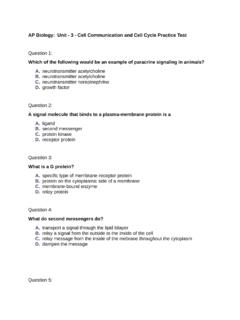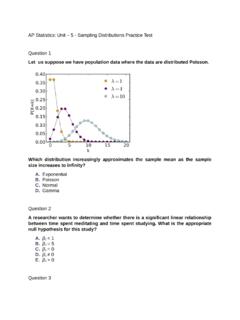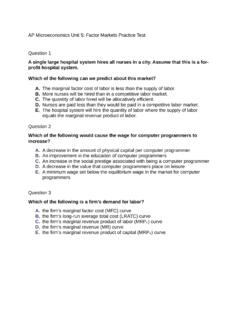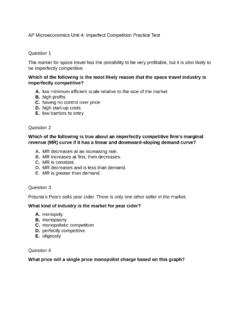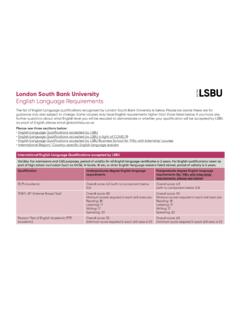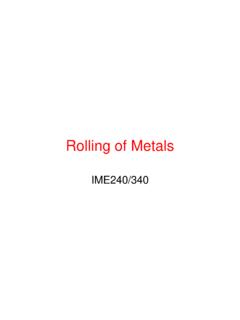Transcription of AP English Language and Composition Practice Test
1 The questions contained in this AP English Language and Composition Practice Exam are written to the content specifications of AP Exams for this subject. Taking this Practice exam should provide students with an idea of their general areas of strengths and weaknesses in preparing for the actual AP Exam. Because this AP English Language and Composition Practice Exam has never been administered as an operational AP Exam, statistical data are not available for calculating potential raw scores or conversions into AP AP English Language and Composition Practice Exam is provided by the College Board for AP Exam preparation. Teachers are permitted to download the materials and make copies to use with their students in a classroom setting only.
2 To maintain the security of this exam, teachers should collect all materials after their administration and keep them in a secure location. Teachers may not redistribute the files electronically for any reason. 2008 The College Board. All rights reserved. College Board, Advanced Placement Program, AP, AP Central, SAT, and the acorn logo are registered trademarks of the College Board. PSAT/NMSQT is a registered trade-mark of the College Board and National Merit Scholarship Corporation. All other products and services may be trademarks of their respective owners. Visit the College Board on the Web: ExamAdvanced PlacementProgramAP English Languageand Composition Contents Directions for Administration.
3 Ii Section I: Multiple-Choice Section II: Free-Response Questions .. 15 Student Answer Sheet for Multiple-Choice Section .. 25 Multiple-Choice Answer Free-Response Scoring The College Board: Connecting Students to College Success The College Board is a not-for-profit membership association whose mission is to connect students to college success and opportunity. Founded in 1900, the association is composed of more than 5,000 schools, colleges, universities, and other educational organizations. Each year, the College Board serves seven million students and their parents, 23,000 high schools, and 3,500 colleges through major programs and services in college admissions, guidance, assessment, financial aid, enrollment, and teaching and learning.
4 Among its best-known programs are the SAT , the PSAT/NMSQT , and the Advanced Placement Program (AP ). The College Board is committed to the principles of excellence and equity, and that commitment is embodied in all of its programs, services, activities, and concerns. Visit the College Board on the Web: AP Central is the official online home for the AP Program: -i-AP English Language and Composition Directions for Administration The AP English Language and Composition Exam is 3 hours and 15 minutes in length and consists of a multiple-choice section and a free-response section. The 60-minute multiple-choice section (Section I) contains 54 questions and accounts for 45 percentof the final grade.
5 The 120-minute free-response section (Section II) contains 3 questions and accounts for 55 percent of the final grade. A 15-minute reading period precedes the free-response section. During this time, students should read Question 1 (the synthesis question), analyze and evaluate the sources, and plan their answers to the question. They may also read the other two essay questions. However, they should NOT begin to write their answers during the reading period. A 10-minute break should be provided after Section I is completed. The actual AP Exam is administered in one session. Students will have the most realistic experience if a complete morning or afternoon is available to administer this Practice exam.
6 If a schedule does not permit one time period for the entire Practice exam administration, it would be acceptable to administer Section I one day and Section II on a subsequent day. Total scores on the multiple-choice section are based only on the number of questions answered correctly. Nopoints are deducted for incorrect answers and no points are awarded for unanswered questions. The use of calculators, or any other electronic devices, is not permitted during the exam. It is suggested that the multiple-choice section of the Practice exam be completed using a pencil and that essay responses be written in blue or black ink to simulate an actual administration. In the multiple-choice exam booklet for the actual AP English Language and Composition exam, the passages and the questions asked about them are always printed on facing pages so that students do not have to turn back to reread a section of the passage or to locate a line reference.
7 Teachers who want to simulate actual exam conditions as accurately as possible may want to keep this feature in mind as they consider how to present the multiple-choice section of the Practice exam to their AP English Language and Composition classes. Teachers will need to provide paper for the students to write their free-response answers. Teachers should provide directions to the students indicating how they wish the responses to be labeled so the teacher will be able to associate the student s response with the question the student intended to answer. Remember that students are not allowed to remove any materials, including scratch work, from the testing site. -ii- Section I Multiple-Choice Questions -1- The inclusion of source material in this exam is not intended as an endorsement by the College Board or ETS of the content, ideas, or values expressed in the material.
8 The material printed here reflects various aspects of the course of study on which this exam is based and is therefore appropriate to use to measure the skills and knowledge of this course. -2- GO ON TO THE NEXT PAGE. English Language AND Composition SECTION I Time 1 hour Directions: This part consists of selections from prose works and questions on their content, form, and style. After reading each passage, choose the best answer to each question and then place the letter of your choice in the corresponding box on the student answer sheet. Note: Pay particular attention to the requirement of questions that contain the words NOT, LEAST, or EXCEPT. Questions 1-14. Read the following passage carefully before you choose your answers.
9 (The following passage is from a contemporary British book about the English Language .) Most people appear fascinated by word origins and the stories that lurk behind the structures in our Language . Paradoxically, they may consider that change is fine as long as it s part of history anything occurring now is calamitous. We ve always been this 5 way. In 1653 John Wallis railed against the use of the word chicken as a singular noun. In 1755 Samuel Johnson wanted to rid the Language of licentious idioms and colloquial barbarisms . The sort of barbarisms he had in mind were words like novel, 10 capture and nowadays. Others were fretting about shortened forms like pants for pantaloons and mob for mobile vulgus.
10 More than five hundred years ago the printer Caxton also worried about the dyuersite & chaunge of langage . Even two thousand years ago 15 Roman verbal hygienists were complaining about changes they saw happening in spoken Latin. Of course, this bad Latin continued to deteriorate until it turned into French, Italian and Spanish. Take a straightforward example. English shows 20 a handy flexibility in being able to convert words to other parts of speech without the addition of any sort of prefix or suffix. Such elasticity is an offshoot of the loss of inflection (endings added for grammatical purposes). Curiously, this is a feature of English that s 25 not appreciated by all, and many speakers are quick to condemn usages such as to impact (on) and a big ask.
